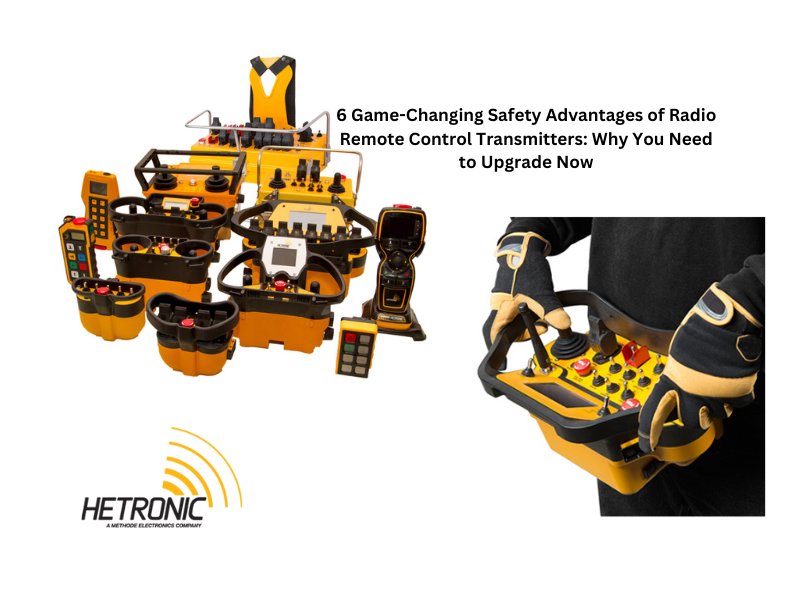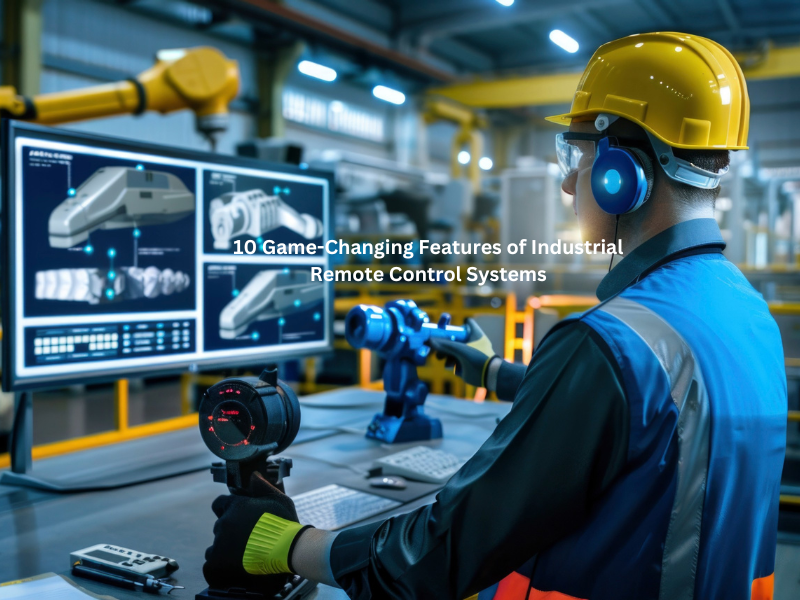Introduction – Radio Remote Control Transmitters
In today’s fast-paced industrial world, safety is paramount. As technology advances, so do the tools we use to protect workers and improve efficiency. One such innovation that’s revolutionizing workplace safety is the radio remote control transmitter. These devices are not just convenient; they’re lifesavers. In this article, we’ll explore six critical safety advantages that make radio remote control transmitters indispensable in modern industrial settings. Whether you’re a plant manager, safety officer, or equipment operator, understanding these benefits could be the key to transforming your workplace safety protocols.
1. Enhanced Operator Distance and Safety
One of the most significant safety advantages of radio remote control transmitters is the increased distance they provide between operators and potentially dangerous machinery. Traditional control methods often require workers to be in close proximity to heavy equipment, exposing them to various risks such as crushing injuries, falls, or contact with hazardous materials.
Radio remote control transmitters allow operators to maintain a safe distance while retaining full control over the equipment. This separation significantly reduces the risk of accidents caused by unexpected machine movements or malfunctions. For instance, in the construction industry, crane operators can now stand at ground level with a clear view of the entire operation, rather than being confined to a cab high above the ground.
According to a study by the National Safety Council, implementing remote control systems in high-risk industrial environments has led to a 35% reduction in operator-related accidents. This statistic alone highlights the immense potential of radio remote control transmitters in safeguarding workers.
2. Improved Visibility and Situational Awareness
When operators are no longer tethered to fixed control panels or confined to equipment cabs, their field of vision expands dramatically. Radio remote control transmitters give operators the freedom to move to optimal viewing positions, ensuring they have a comprehensive view of the work area and any potential hazards.
This improved visibility translates directly into enhanced situational awareness. Operators can quickly identify and respond to changes in the environment, such as the movement of other workers, shifting loads, or emerging obstacles. The ability to see the entire operation from various angles allows for more informed decision-making and quicker reaction times in emergencies.
A survey conducted by the Occupational Safety and Health Administration (OSHA) found that 70% of industrial accidents were attributed to poor visibility or lack of situational awareness. By addressing these issues, radio remote control transmitters play a crucial role in mitigating a major source of workplace incidents.
3. Reduction of Repetitive Strain Injuries
Repetitive strain injuries (RSIs) are a common concern in industries that require prolonged operation of machinery or repetitive motions. Traditional control systems often involve levers, joysticks, or buttons that can lead to fatigue and stress on the operator’s muscles and joints over time.
Radio remote control transmitters are designed with ergonomics in mind. They are typically lightweight and can be operated with minimal physical exertion. This design reduces the risk of RSIs and allows operators to work for longer periods without discomfort or fatigue.
The Bureau of Labor Statistics reports that RSIs account for 33% of all workplace injuries. By implementing radio remote control transmitters, companies have seen a decrease in RSI-related claims by up to 40%, resulting in fewer lost workdays and increased productivity.
4. Emergency Stop Functionality
Safety features are at the heart of radio remote control transmitter design, and perhaps none is more critical than the emergency stop function. These devices are equipped with easily accessible emergency stop buttons that can immediately halt all operations in case of a dangerous situation.
The speed and reliability of this feature can mean the difference between a near-miss and a catastrophic accident. Unlike traditional systems where an operator might need to reach a fixed emergency stop button, radio remote controls ensure that this life-saving function is always within arm’s reach.
Industry data shows that the average response time for activating an emergency stop has been reduced from 3.2 seconds with traditional controls to just 0.8 seconds with radio remote transmitters. This significant improvement in reaction time has been credited with preventing countless potential accidents.
5. Customizable Controls for Specific Safety Needs
One size does not fit all when it comes to industrial safety. Different industries and even different processes within the same industry may have unique safety requirements. Radio remote control transmitters offer a level of customization that is unmatched by traditional control systems.
Manufacturers can tailor the layout, sensitivity, and functionality of these transmitters to meet specific safety protocols. For example, certain buttons can be programmed with safety interlocks to prevent accidental activation of critical functions. Speed limiters can be incorporated to ensure equipment operates within safe parameters, regardless of operator input.
This customization extends to the integration of additional safety features such as tilt sensors, which can automatically shut down equipment if the operator falls or the transmitter is dropped. According to a report by the Industrial Safety & Hygiene News, companies that implemented customized radio remote controls saw a 28% increase in overall safety compliance.
6. Data Logging and Analysis for Continuous Improvement
Modern radio remote control transmitters are not just control devices; they’re sophisticated data collection tools. Many models come equipped with logging capabilities that record operational data, including usage patterns, emergency stop activations, and even near-miss incidents.
This wealth of information is invaluable for safety managers and analysts. By reviewing this data, companies can identify trends, pinpoint areas of risk, and develop more effective safety protocols. The ability to analyze actual usage data allows for evidence-based decision-making in safety policy development.
A case study from a leading manufacturing plant showed that after implementing data logging features on their radio remote transmitters, they were able to reduce workplace accidents by 22% within the first year through targeted safety improvements based on the collected data.
Frequently Asked Questions:
Q: Are radio remote control transmitters reliable in all industrial environments?
A: While extremely reliable, it’s important to choose transmitters designed for specific industrial conditions. Factors like electromagnetic interference, extreme temperatures, or corrosive atmospheres should be considered when selecting a system.
Q: How do radio remote control transmitters ensure security against unauthorized use?
A: Most modern transmitters use advanced encryption and unique pairing protocols to prevent unauthorized access. Some systems also incorporate biometric authentication for an additional layer of security.
Q: Can radio remote control transmitters be integrated with existing safety systems?
A: Yes, many radio remote control systems are designed to integrate seamlessly with existing safety infrastructure, including emergency shutdown systems and safety PLCs.
Q: What happens if the radio signal is lost during operation?
A: High-quality radio remote control systems are designed with fail-safe mechanisms. If the signal is lost, the equipment will automatically enter a safe state, typically stopping all operations until the connection is re-established.
Q: How does the battery life of radio remote transmitters impact safety?
A: Battery life is a crucial safety consideration. Most professional-grade transmitters are equipped with long-lasting batteries and clear indicators of battery status to prevent unexpected power loss during critical operations.
Conclusion – Radio Remote Control Transmitters
The six safety advantages of radio remote control transmitters—enhanced operator distance, improved visibility, reduction of repetitive strain injuries, emergency stop functionality, customizable controls, and data logging capabilities—represent a significant leap forward in industrial safety technology. By implementing these systems, companies not only protect their most valuable asset—their workforce—but also improve efficiency and compliance.
As we look to the future, the continued evolution of radio remote control technology promises even greater advancements in workplace safety. From AI-assisted operation to augmented reality interfaces, the potential for further reducing risks and enhancing operator capabilities is boundless.
The question is no longer whether companies can afford to implement radio remote control transmitters, but rather, can they afford not to? With lives at stake and the clear benefits outlined in this article, the adoption of this technology is not just a smart business decision—it’s a moral imperative.
Take action today to assess how radio remote control transmitters can elevate safety standards in your operations. Your workers, and your bottom line, will thank you.





